Leadership and Management: Situational and Contingency Report
VerifiedAdded on 2022/12/28
|13
|4348
|73
Report
AI Summary
This report delves into the core concepts of leadership and management, providing a detailed analysis of the roles and characteristics of leaders and managers. It explores the differences between leadership and management, illustrating these with real-world examples from companies like TESCO. The report covers key management functions such as planning, organizing, directing, and controlling, and it further examines the application of situational leadership, systems leadership, and contingency approaches. The report also analyzes key approaches to operations management, emphasizing the role of leaders and managers in achieving business objectives. Additionally, it assesses factors within the business environment that impact operational management and decision-making by leaders and managers. The report provides a comprehensive overview of these critical business concepts.
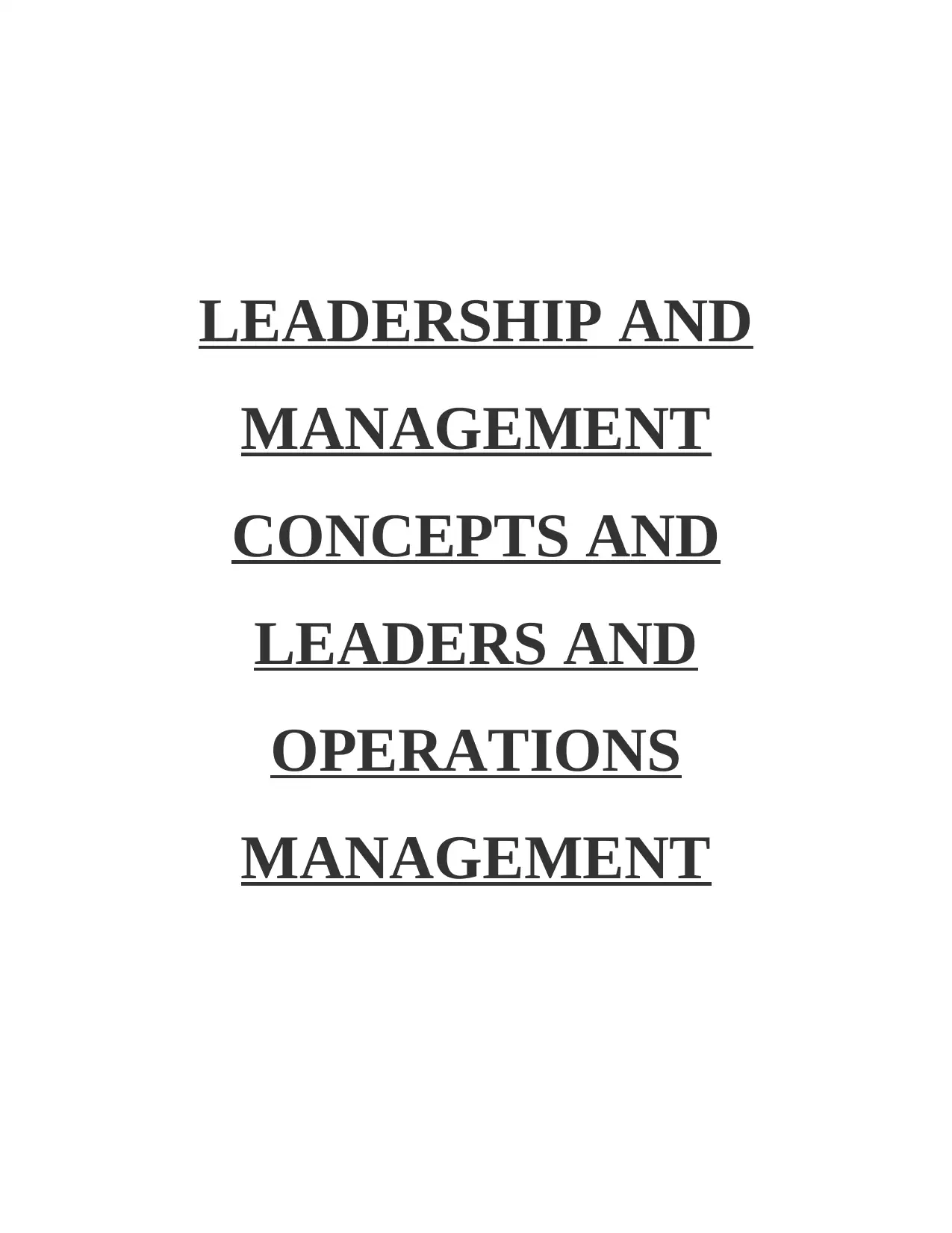
LEADERSHIP AND
MANAGEMENT
CONCEPTS AND
LEADERS AND
OPERATIONS
MANAGEMENT
MANAGEMENT
CONCEPTS AND
LEADERS AND
OPERATIONS
MANAGEMENT
Paraphrase This Document
Need a fresh take? Get an instant paraphrase of this document with our AI Paraphraser
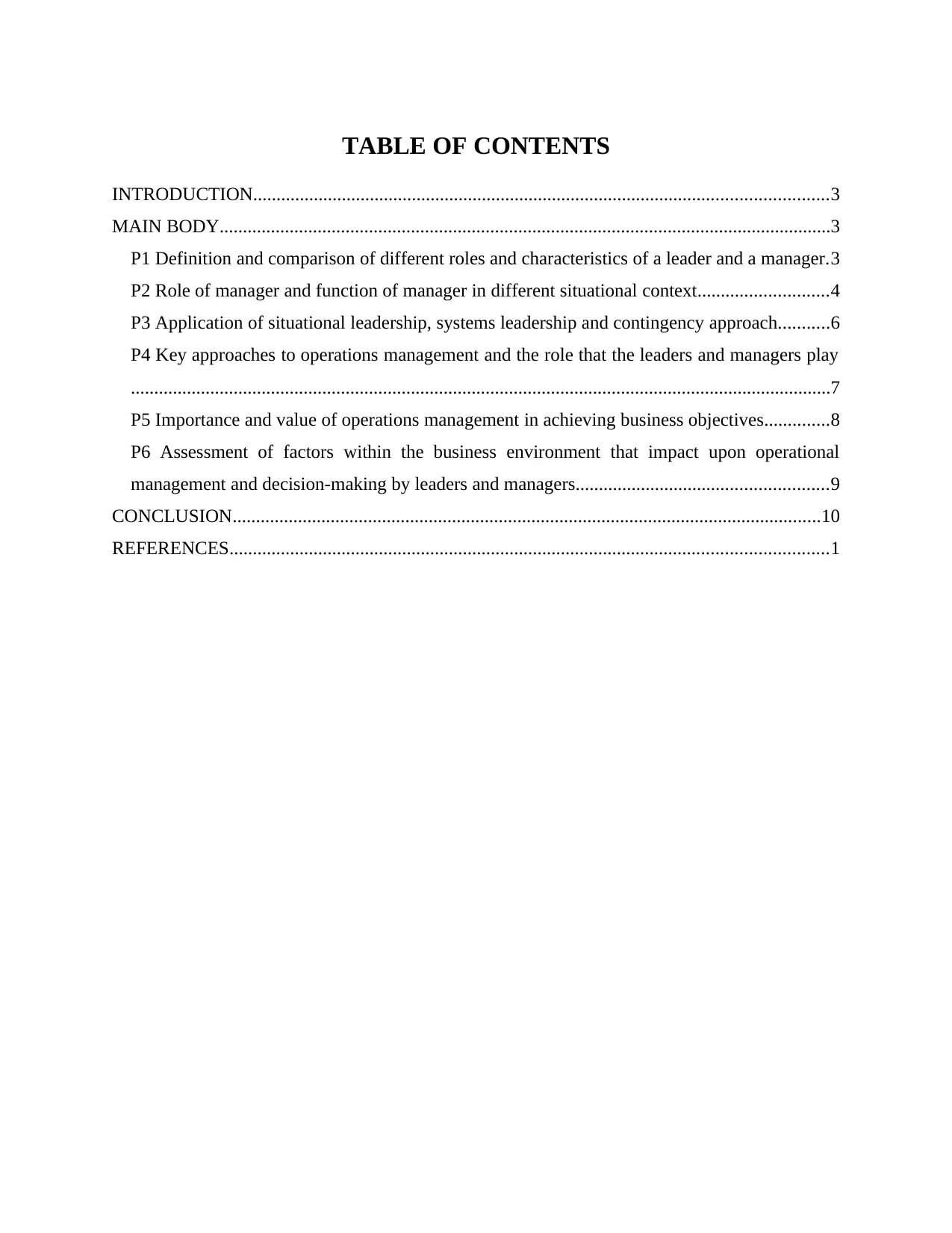
TABLE OF CONTENTS
INTRODUCTION...........................................................................................................................3
MAIN BODY...................................................................................................................................3
P1 Definition and comparison of different roles and characteristics of a leader and a manager.3
P2 Role of manager and function of manager in different situational context............................4
P3 Application of situational leadership, systems leadership and contingency approach...........6
P4 Key approaches to operations management and the role that the leaders and managers play
......................................................................................................................................................7
P5 Importance and value of operations management in achieving business objectives..............8
P6 Assessment of factors within the business environment that impact upon operational
management and decision-making by leaders and managers......................................................9
CONCLUSION..............................................................................................................................10
REFERENCES................................................................................................................................1
INTRODUCTION...........................................................................................................................3
MAIN BODY...................................................................................................................................3
P1 Definition and comparison of different roles and characteristics of a leader and a manager.3
P2 Role of manager and function of manager in different situational context............................4
P3 Application of situational leadership, systems leadership and contingency approach...........6
P4 Key approaches to operations management and the role that the leaders and managers play
......................................................................................................................................................7
P5 Importance and value of operations management in achieving business objectives..............8
P6 Assessment of factors within the business environment that impact upon operational
management and decision-making by leaders and managers......................................................9
CONCLUSION..............................................................................................................................10
REFERENCES................................................................................................................................1
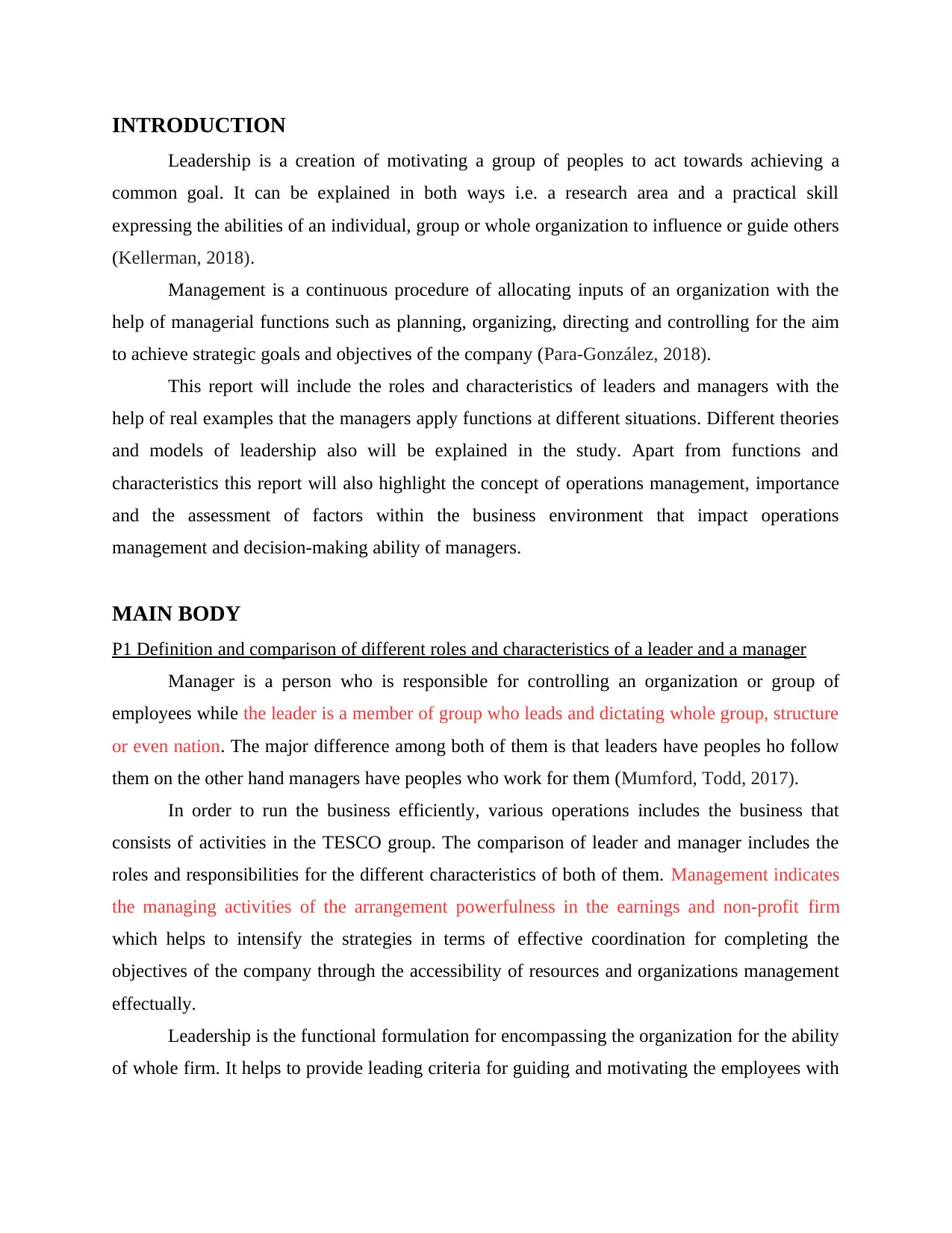
INTRODUCTION
Leadership is a creation of motivating a group of peoples to act towards achieving a
common goal. It can be explained in both ways i.e. a research area and a practical skill
expressing the abilities of an individual, group or whole organization to influence or guide others
(Kellerman, 2018).
Management is a continuous procedure of allocating inputs of an organization with the
help of managerial functions such as planning, organizing, directing and controlling for the aim
to achieve strategic goals and objectives of the company (Para-González, 2018).
This report will include the roles and characteristics of leaders and managers with the
help of real examples that the managers apply functions at different situations. Different theories
and models of leadership also will be explained in the study. Apart from functions and
characteristics this report will also highlight the concept of operations management, importance
and the assessment of factors within the business environment that impact operations
management and decision-making ability of managers.
MAIN BODY
P1 Definition and comparison of different roles and characteristics of a leader and a manager
Manager is a person who is responsible for controlling an organization or group of
employees while the leader is a member of group who leads and dictating whole group, structure
or even nation. The major difference among both of them is that leaders have peoples ho follow
them on the other hand managers have peoples who work for them (Mumford, Todd, 2017).
In order to run the business efficiently, various operations includes the business that
consists of activities in the TESCO group. The comparison of leader and manager includes the
roles and responsibilities for the different characteristics of both of them. Management indicates
the managing activities of the arrangement powerfulness in the earnings and non-profit firm
which helps to intensify the strategies in terms of effective coordination for completing the
objectives of the company through the accessibility of resources and organizations management
effectually.
Leadership is the functional formulation for encompassing the organization for the ability
of whole firm. It helps to provide leading criteria for guiding and motivating the employees with
Leadership is a creation of motivating a group of peoples to act towards achieving a
common goal. It can be explained in both ways i.e. a research area and a practical skill
expressing the abilities of an individual, group or whole organization to influence or guide others
(Kellerman, 2018).
Management is a continuous procedure of allocating inputs of an organization with the
help of managerial functions such as planning, organizing, directing and controlling for the aim
to achieve strategic goals and objectives of the company (Para-González, 2018).
This report will include the roles and characteristics of leaders and managers with the
help of real examples that the managers apply functions at different situations. Different theories
and models of leadership also will be explained in the study. Apart from functions and
characteristics this report will also highlight the concept of operations management, importance
and the assessment of factors within the business environment that impact operations
management and decision-making ability of managers.
MAIN BODY
P1 Definition and comparison of different roles and characteristics of a leader and a manager
Manager is a person who is responsible for controlling an organization or group of
employees while the leader is a member of group who leads and dictating whole group, structure
or even nation. The major difference among both of them is that leaders have peoples ho follow
them on the other hand managers have peoples who work for them (Mumford, Todd, 2017).
In order to run the business efficiently, various operations includes the business that
consists of activities in the TESCO group. The comparison of leader and manager includes the
roles and responsibilities for the different characteristics of both of them. Management indicates
the managing activities of the arrangement powerfulness in the earnings and non-profit firm
which helps to intensify the strategies in terms of effective coordination for completing the
objectives of the company through the accessibility of resources and organizations management
effectually.
Leadership is the functional formulation for encompassing the organization for the ability
of whole firm. It helps to provide leading criteria for guiding and motivating the employees with
⊘ This is a preview!⊘
Do you want full access?
Subscribe today to unlock all pages.

Trusted by 1+ million students worldwide
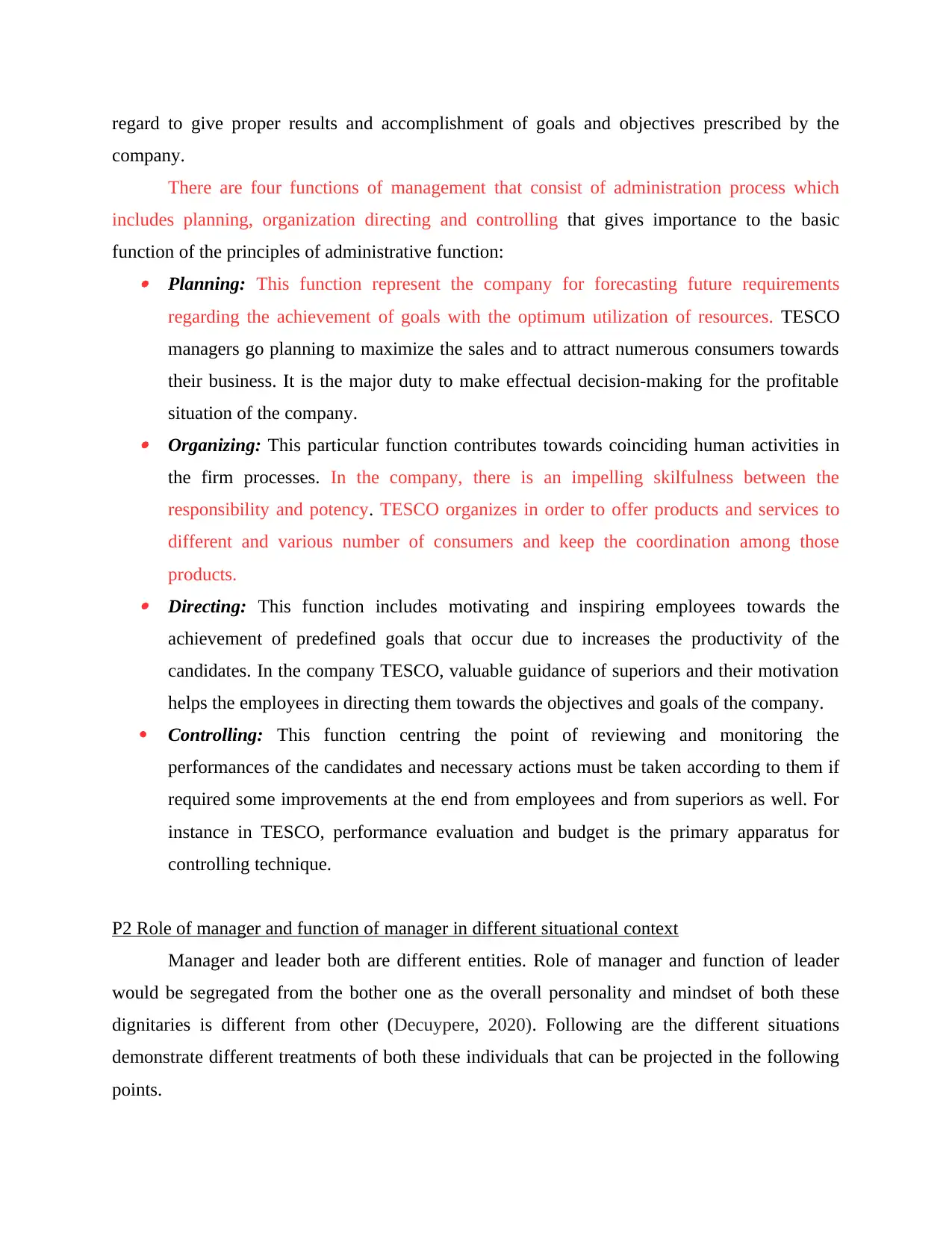
regard to give proper results and accomplishment of goals and objectives prescribed by the
company.
There are four functions of management that consist of administration process which
includes planning, organization directing and controlling that gives importance to the basic
function of the principles of administrative function: Planning: This function represent the company for forecasting future requirements
regarding the achievement of goals with the optimum utilization of resources. TESCO
managers go planning to maximize the sales and to attract numerous consumers towards
their business. It is the major duty to make effectual decision-making for the profitable
situation of the company. Organizing: This particular function contributes towards coinciding human activities in
the firm processes. In the company, there is an impelling skilfulness between the
responsibility and potency. TESCO organizes in order to offer products and services to
different and various number of consumers and keep the coordination among those
products. Directing: This function includes motivating and inspiring employees towards the
achievement of predefined goals that occur due to increases the productivity of the
candidates. In the company TESCO, valuable guidance of superiors and their motivation
helps the employees in directing them towards the objectives and goals of the company.
Controlling: This function centring the point of reviewing and monitoring the
performances of the candidates and necessary actions must be taken according to them if
required some improvements at the end from employees and from superiors as well. For
instance in TESCO, performance evaluation and budget is the primary apparatus for
controlling technique.
P2 Role of manager and function of manager in different situational context
Manager and leader both are different entities. Role of manager and function of leader
would be segregated from the bother one as the overall personality and mindset of both these
dignitaries is different from other (Decuypere, 2020). Following are the different situations
demonstrate different treatments of both these individuals that can be projected in the following
points.
company.
There are four functions of management that consist of administration process which
includes planning, organization directing and controlling that gives importance to the basic
function of the principles of administrative function: Planning: This function represent the company for forecasting future requirements
regarding the achievement of goals with the optimum utilization of resources. TESCO
managers go planning to maximize the sales and to attract numerous consumers towards
their business. It is the major duty to make effectual decision-making for the profitable
situation of the company. Organizing: This particular function contributes towards coinciding human activities in
the firm processes. In the company, there is an impelling skilfulness between the
responsibility and potency. TESCO organizes in order to offer products and services to
different and various number of consumers and keep the coordination among those
products. Directing: This function includes motivating and inspiring employees towards the
achievement of predefined goals that occur due to increases the productivity of the
candidates. In the company TESCO, valuable guidance of superiors and their motivation
helps the employees in directing them towards the objectives and goals of the company.
Controlling: This function centring the point of reviewing and monitoring the
performances of the candidates and necessary actions must be taken according to them if
required some improvements at the end from employees and from superiors as well. For
instance in TESCO, performance evaluation and budget is the primary apparatus for
controlling technique.
P2 Role of manager and function of manager in different situational context
Manager and leader both are different entities. Role of manager and function of leader
would be segregated from the bother one as the overall personality and mindset of both these
dignitaries is different from other (Decuypere, 2020). Following are the different situations
demonstrate different treatments of both these individuals that can be projected in the following
points.
Paraphrase This Document
Need a fresh take? Get an instant paraphrase of this document with our AI Paraphraser
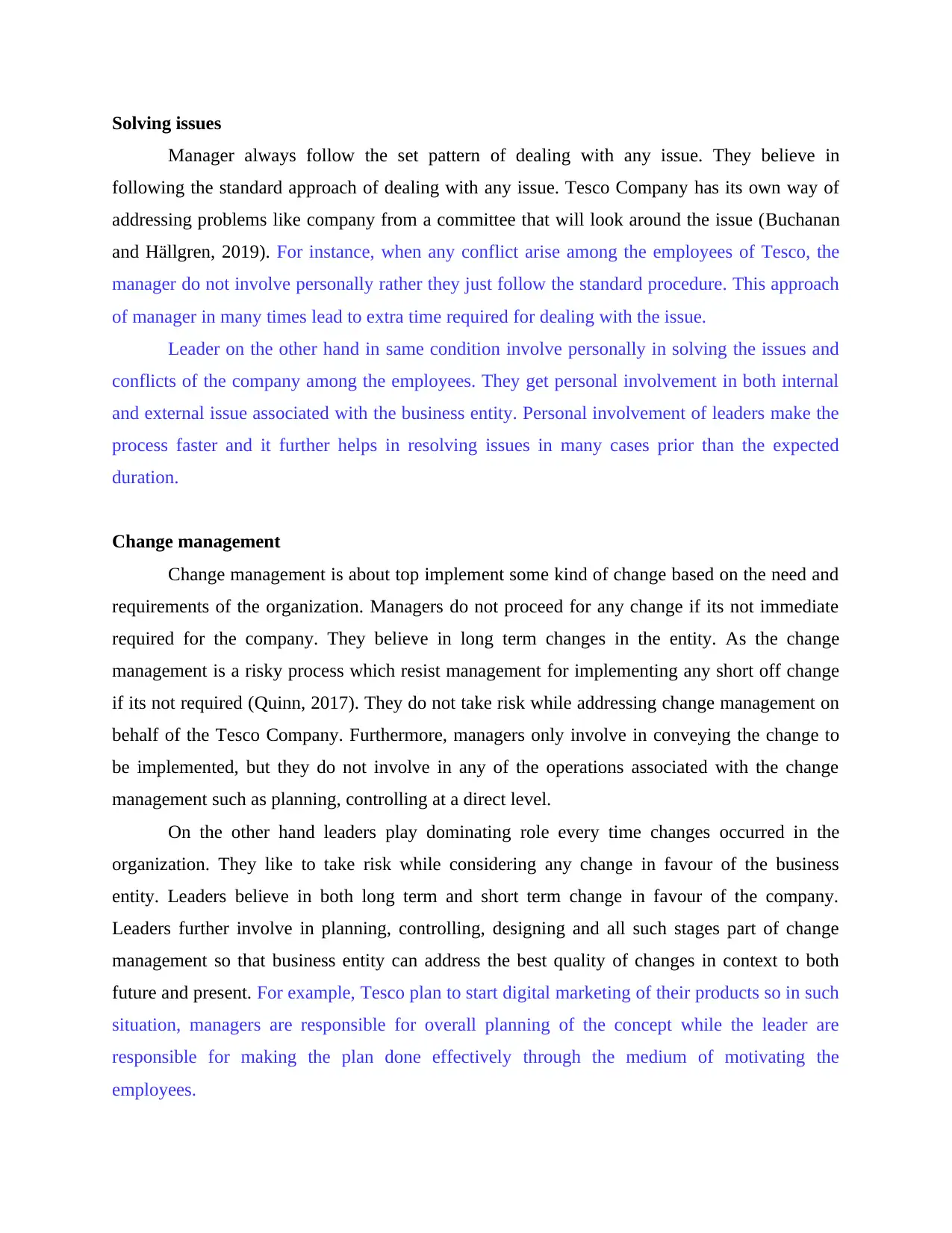
Solving issues
Manager always follow the set pattern of dealing with any issue. They believe in
following the standard approach of dealing with any issue. Tesco Company has its own way of
addressing problems like company from a committee that will look around the issue (Buchanan
and Hällgren, 2019). For instance, when any conflict arise among the employees of Tesco, the
manager do not involve personally rather they just follow the standard procedure. This approach
of manager in many times lead to extra time required for dealing with the issue.
Leader on the other hand in same condition involve personally in solving the issues and
conflicts of the company among the employees. They get personal involvement in both internal
and external issue associated with the business entity. Personal involvement of leaders make the
process faster and it further helps in resolving issues in many cases prior than the expected
duration.
Change management
Change management is about top implement some kind of change based on the need and
requirements of the organization. Managers do not proceed for any change if its not immediate
required for the company. They believe in long term changes in the entity. As the change
management is a risky process which resist management for implementing any short off change
if its not required (Quinn, 2017). They do not take risk while addressing change management on
behalf of the Tesco Company. Furthermore, managers only involve in conveying the change to
be implemented, but they do not involve in any of the operations associated with the change
management such as planning, controlling at a direct level.
On the other hand leaders play dominating role every time changes occurred in the
organization. They like to take risk while considering any change in favour of the business
entity. Leaders believe in both long term and short term change in favour of the company.
Leaders further involve in planning, controlling, designing and all such stages part of change
management so that business entity can address the best quality of changes in context to both
future and present. For example, Tesco plan to start digital marketing of their products so in such
situation, managers are responsible for overall planning of the concept while the leader are
responsible for making the plan done effectively through the medium of motivating the
employees.
Manager always follow the set pattern of dealing with any issue. They believe in
following the standard approach of dealing with any issue. Tesco Company has its own way of
addressing problems like company from a committee that will look around the issue (Buchanan
and Hällgren, 2019). For instance, when any conflict arise among the employees of Tesco, the
manager do not involve personally rather they just follow the standard procedure. This approach
of manager in many times lead to extra time required for dealing with the issue.
Leader on the other hand in same condition involve personally in solving the issues and
conflicts of the company among the employees. They get personal involvement in both internal
and external issue associated with the business entity. Personal involvement of leaders make the
process faster and it further helps in resolving issues in many cases prior than the expected
duration.
Change management
Change management is about top implement some kind of change based on the need and
requirements of the organization. Managers do not proceed for any change if its not immediate
required for the company. They believe in long term changes in the entity. As the change
management is a risky process which resist management for implementing any short off change
if its not required (Quinn, 2017). They do not take risk while addressing change management on
behalf of the Tesco Company. Furthermore, managers only involve in conveying the change to
be implemented, but they do not involve in any of the operations associated with the change
management such as planning, controlling at a direct level.
On the other hand leaders play dominating role every time changes occurred in the
organization. They like to take risk while considering any change in favour of the business
entity. Leaders believe in both long term and short term change in favour of the company.
Leaders further involve in planning, controlling, designing and all such stages part of change
management so that business entity can address the best quality of changes in context to both
future and present. For example, Tesco plan to start digital marketing of their products so in such
situation, managers are responsible for overall planning of the concept while the leader are
responsible for making the plan done effectively through the medium of motivating the
employees.
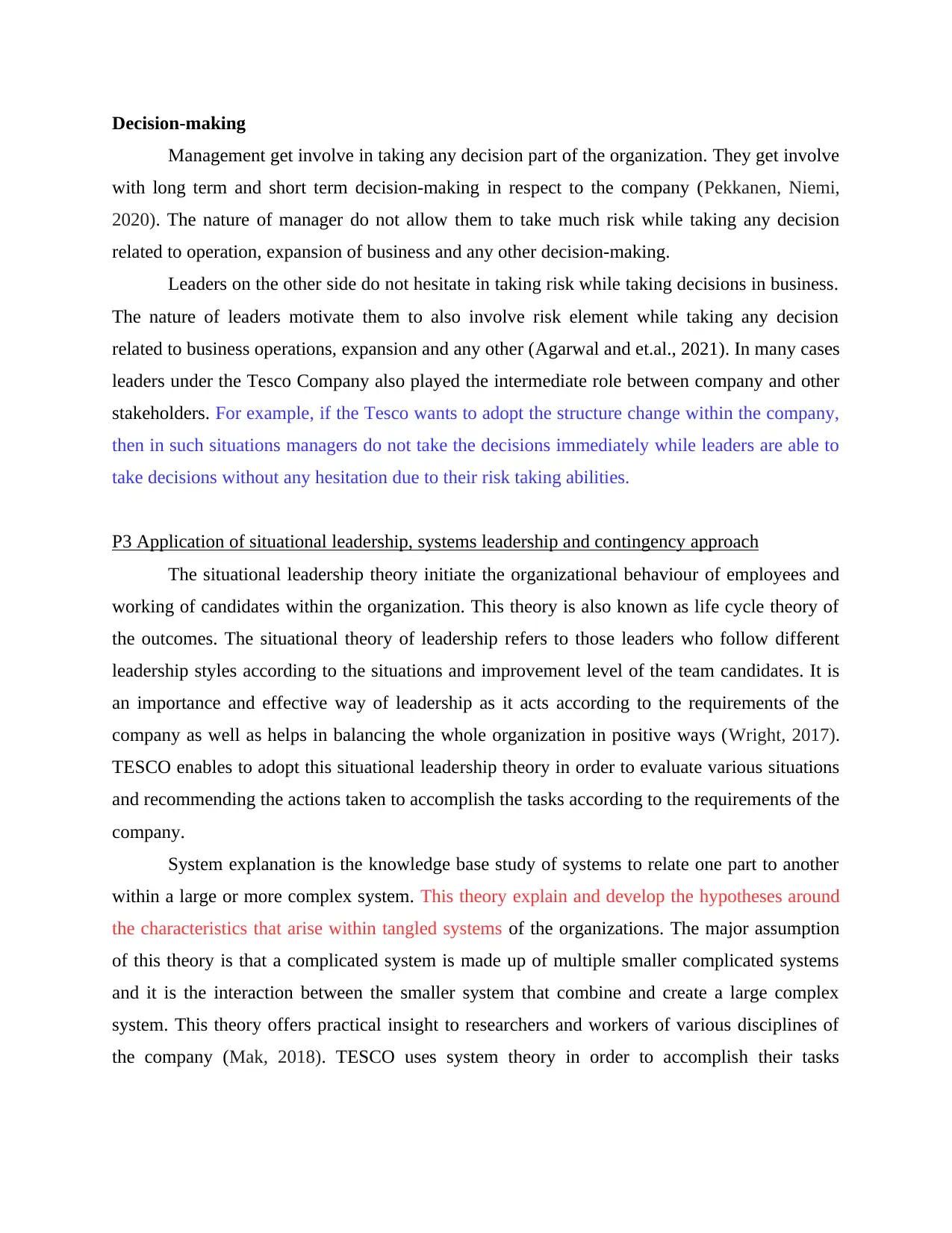
Decision-making
Management get involve in taking any decision part of the organization. They get involve
with long term and short term decision-making in respect to the company (Pekkanen, Niemi,
2020). The nature of manager do not allow them to take much risk while taking any decision
related to operation, expansion of business and any other decision-making.
Leaders on the other side do not hesitate in taking risk while taking decisions in business.
The nature of leaders motivate them to also involve risk element while taking any decision
related to business operations, expansion and any other (Agarwal and et.al., 2021). In many cases
leaders under the Tesco Company also played the intermediate role between company and other
stakeholders. For example, if the Tesco wants to adopt the structure change within the company,
then in such situations managers do not take the decisions immediately while leaders are able to
take decisions without any hesitation due to their risk taking abilities.
P3 Application of situational leadership, systems leadership and contingency approach
The situational leadership theory initiate the organizational behaviour of employees and
working of candidates within the organization. This theory is also known as life cycle theory of
the outcomes. The situational theory of leadership refers to those leaders who follow different
leadership styles according to the situations and improvement level of the team candidates. It is
an importance and effective way of leadership as it acts according to the requirements of the
company as well as helps in balancing the whole organization in positive ways (Wright, 2017).
TESCO enables to adopt this situational leadership theory in order to evaluate various situations
and recommending the actions taken to accomplish the tasks according to the requirements of the
company.
System explanation is the knowledge base study of systems to relate one part to another
within a large or more complex system. This theory explain and develop the hypotheses around
the characteristics that arise within tangled systems of the organizations. The major assumption
of this theory is that a complicated system is made up of multiple smaller complicated systems
and it is the interaction between the smaller system that combine and create a large complex
system. This theory offers practical insight to researchers and workers of various disciplines of
the company (Mak, 2018). TESCO uses system theory in order to accomplish their tasks
Management get involve in taking any decision part of the organization. They get involve
with long term and short term decision-making in respect to the company (Pekkanen, Niemi,
2020). The nature of manager do not allow them to take much risk while taking any decision
related to operation, expansion of business and any other decision-making.
Leaders on the other side do not hesitate in taking risk while taking decisions in business.
The nature of leaders motivate them to also involve risk element while taking any decision
related to business operations, expansion and any other (Agarwal and et.al., 2021). In many cases
leaders under the Tesco Company also played the intermediate role between company and other
stakeholders. For example, if the Tesco wants to adopt the structure change within the company,
then in such situations managers do not take the decisions immediately while leaders are able to
take decisions without any hesitation due to their risk taking abilities.
P3 Application of situational leadership, systems leadership and contingency approach
The situational leadership theory initiate the organizational behaviour of employees and
working of candidates within the organization. This theory is also known as life cycle theory of
the outcomes. The situational theory of leadership refers to those leaders who follow different
leadership styles according to the situations and improvement level of the team candidates. It is
an importance and effective way of leadership as it acts according to the requirements of the
company as well as helps in balancing the whole organization in positive ways (Wright, 2017).
TESCO enables to adopt this situational leadership theory in order to evaluate various situations
and recommending the actions taken to accomplish the tasks according to the requirements of the
company.
System explanation is the knowledge base study of systems to relate one part to another
within a large or more complex system. This theory explain and develop the hypotheses around
the characteristics that arise within tangled systems of the organizations. The major assumption
of this theory is that a complicated system is made up of multiple smaller complicated systems
and it is the interaction between the smaller system that combine and create a large complex
system. This theory offers practical insight to researchers and workers of various disciplines of
the company (Mak, 2018). TESCO uses system theory in order to accomplish their tasks
⊘ This is a preview!⊘
Do you want full access?
Subscribe today to unlock all pages.

Trusted by 1+ million students worldwide
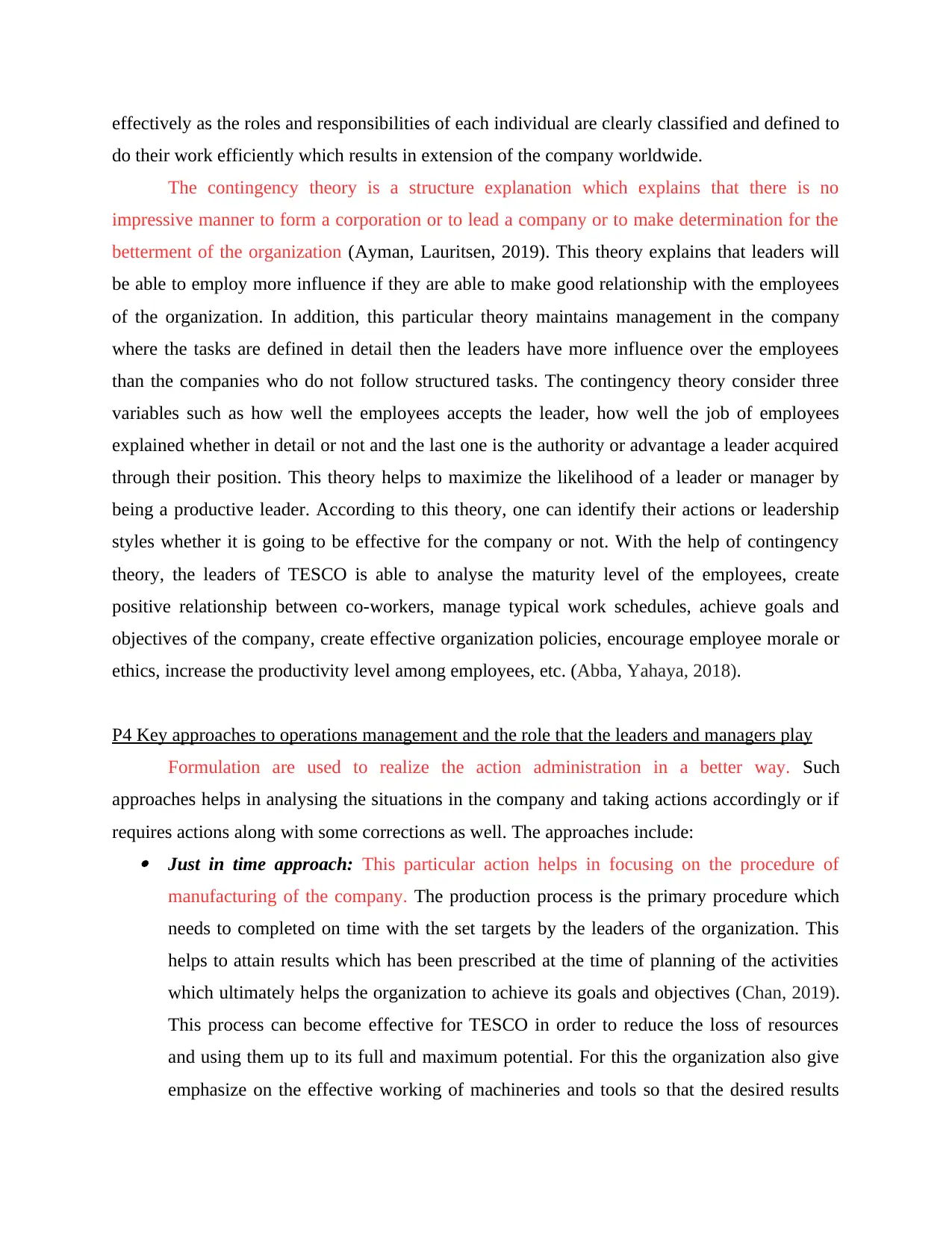
effectively as the roles and responsibilities of each individual are clearly classified and defined to
do their work efficiently which results in extension of the company worldwide.
The contingency theory is a structure explanation which explains that there is no
impressive manner to form a corporation or to lead a company or to make determination for the
betterment of the organization (Ayman, Lauritsen, 2019). This theory explains that leaders will
be able to employ more influence if they are able to make good relationship with the employees
of the organization. In addition, this particular theory maintains management in the company
where the tasks are defined in detail then the leaders have more influence over the employees
than the companies who do not follow structured tasks. The contingency theory consider three
variables such as how well the employees accepts the leader, how well the job of employees
explained whether in detail or not and the last one is the authority or advantage a leader acquired
through their position. This theory helps to maximize the likelihood of a leader or manager by
being a productive leader. According to this theory, one can identify their actions or leadership
styles whether it is going to be effective for the company or not. With the help of contingency
theory, the leaders of TESCO is able to analyse the maturity level of the employees, create
positive relationship between co-workers, manage typical work schedules, achieve goals and
objectives of the company, create effective organization policies, encourage employee morale or
ethics, increase the productivity level among employees, etc. (Abba, Yahaya, 2018).
P4 Key approaches to operations management and the role that the leaders and managers play
Formulation are used to realize the action administration in a better way. Such
approaches helps in analysing the situations in the company and taking actions accordingly or if
requires actions along with some corrections as well. The approaches include: Just in time approach: This particular action helps in focusing on the procedure of
manufacturing of the company. The production process is the primary procedure which
needs to completed on time with the set targets by the leaders of the organization. This
helps to attain results which has been prescribed at the time of planning of the activities
which ultimately helps the organization to achieve its goals and objectives (Chan, 2019).
This process can become effective for TESCO in order to reduce the loss of resources
and using them up to its full and maximum potential. For this the organization also give
emphasize on the effective working of machineries and tools so that the desired results
do their work efficiently which results in extension of the company worldwide.
The contingency theory is a structure explanation which explains that there is no
impressive manner to form a corporation or to lead a company or to make determination for the
betterment of the organization (Ayman, Lauritsen, 2019). This theory explains that leaders will
be able to employ more influence if they are able to make good relationship with the employees
of the organization. In addition, this particular theory maintains management in the company
where the tasks are defined in detail then the leaders have more influence over the employees
than the companies who do not follow structured tasks. The contingency theory consider three
variables such as how well the employees accepts the leader, how well the job of employees
explained whether in detail or not and the last one is the authority or advantage a leader acquired
through their position. This theory helps to maximize the likelihood of a leader or manager by
being a productive leader. According to this theory, one can identify their actions or leadership
styles whether it is going to be effective for the company or not. With the help of contingency
theory, the leaders of TESCO is able to analyse the maturity level of the employees, create
positive relationship between co-workers, manage typical work schedules, achieve goals and
objectives of the company, create effective organization policies, encourage employee morale or
ethics, increase the productivity level among employees, etc. (Abba, Yahaya, 2018).
P4 Key approaches to operations management and the role that the leaders and managers play
Formulation are used to realize the action administration in a better way. Such
approaches helps in analysing the situations in the company and taking actions accordingly or if
requires actions along with some corrections as well. The approaches include: Just in time approach: This particular action helps in focusing on the procedure of
manufacturing of the company. The production process is the primary procedure which
needs to completed on time with the set targets by the leaders of the organization. This
helps to attain results which has been prescribed at the time of planning of the activities
which ultimately helps the organization to achieve its goals and objectives (Chan, 2019).
This process can become effective for TESCO in order to reduce the loss of resources
and using them up to its full and maximum potential. For this the organization also give
emphasize on the effective working of machineries and tools so that the desired results
Paraphrase This Document
Need a fresh take? Get an instant paraphrase of this document with our AI Paraphraser
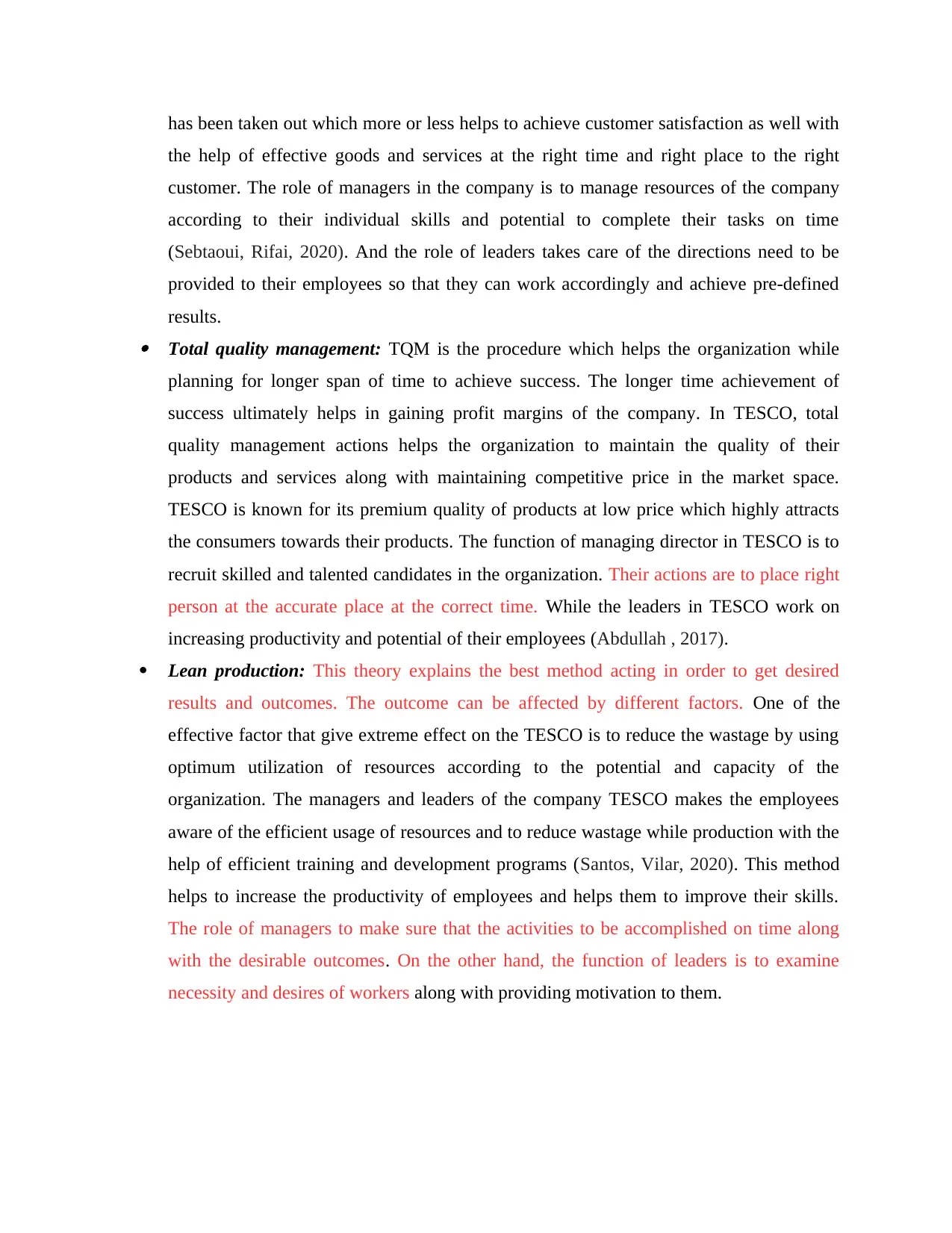
has been taken out which more or less helps to achieve customer satisfaction as well with
the help of effective goods and services at the right time and right place to the right
customer. The role of managers in the company is to manage resources of the company
according to their individual skills and potential to complete their tasks on time
(Sebtaoui, Rifai, 2020). And the role of leaders takes care of the directions need to be
provided to their employees so that they can work accordingly and achieve pre-defined
results. Total quality management: TQM is the procedure which helps the organization while
planning for longer span of time to achieve success. The longer time achievement of
success ultimately helps in gaining profit margins of the company. In TESCO, total
quality management actions helps the organization to maintain the quality of their
products and services along with maintaining competitive price in the market space.
TESCO is known for its premium quality of products at low price which highly attracts
the consumers towards their products. The function of managing director in TESCO is to
recruit skilled and talented candidates in the organization. Their actions are to place right
person at the accurate place at the correct time. While the leaders in TESCO work on
increasing productivity and potential of their employees (Abdullah , 2017).
Lean production: This theory explains the best method acting in order to get desired
results and outcomes. The outcome can be affected by different factors. One of the
effective factor that give extreme effect on the TESCO is to reduce the wastage by using
optimum utilization of resources according to the potential and capacity of the
organization. The managers and leaders of the company TESCO makes the employees
aware of the efficient usage of resources and to reduce wastage while production with the
help of efficient training and development programs (Santos, Vilar, 2020). This method
helps to increase the productivity of employees and helps them to improve their skills.
The role of managers to make sure that the activities to be accomplished on time along
with the desirable outcomes. On the other hand, the function of leaders is to examine
necessity and desires of workers along with providing motivation to them.
the help of effective goods and services at the right time and right place to the right
customer. The role of managers in the company is to manage resources of the company
according to their individual skills and potential to complete their tasks on time
(Sebtaoui, Rifai, 2020). And the role of leaders takes care of the directions need to be
provided to their employees so that they can work accordingly and achieve pre-defined
results. Total quality management: TQM is the procedure which helps the organization while
planning for longer span of time to achieve success. The longer time achievement of
success ultimately helps in gaining profit margins of the company. In TESCO, total
quality management actions helps the organization to maintain the quality of their
products and services along with maintaining competitive price in the market space.
TESCO is known for its premium quality of products at low price which highly attracts
the consumers towards their products. The function of managing director in TESCO is to
recruit skilled and talented candidates in the organization. Their actions are to place right
person at the accurate place at the correct time. While the leaders in TESCO work on
increasing productivity and potential of their employees (Abdullah , 2017).
Lean production: This theory explains the best method acting in order to get desired
results and outcomes. The outcome can be affected by different factors. One of the
effective factor that give extreme effect on the TESCO is to reduce the wastage by using
optimum utilization of resources according to the potential and capacity of the
organization. The managers and leaders of the company TESCO makes the employees
aware of the efficient usage of resources and to reduce wastage while production with the
help of efficient training and development programs (Santos, Vilar, 2020). This method
helps to increase the productivity of employees and helps them to improve their skills.
The role of managers to make sure that the activities to be accomplished on time along
with the desirable outcomes. On the other hand, the function of leaders is to examine
necessity and desires of workers along with providing motivation to them.
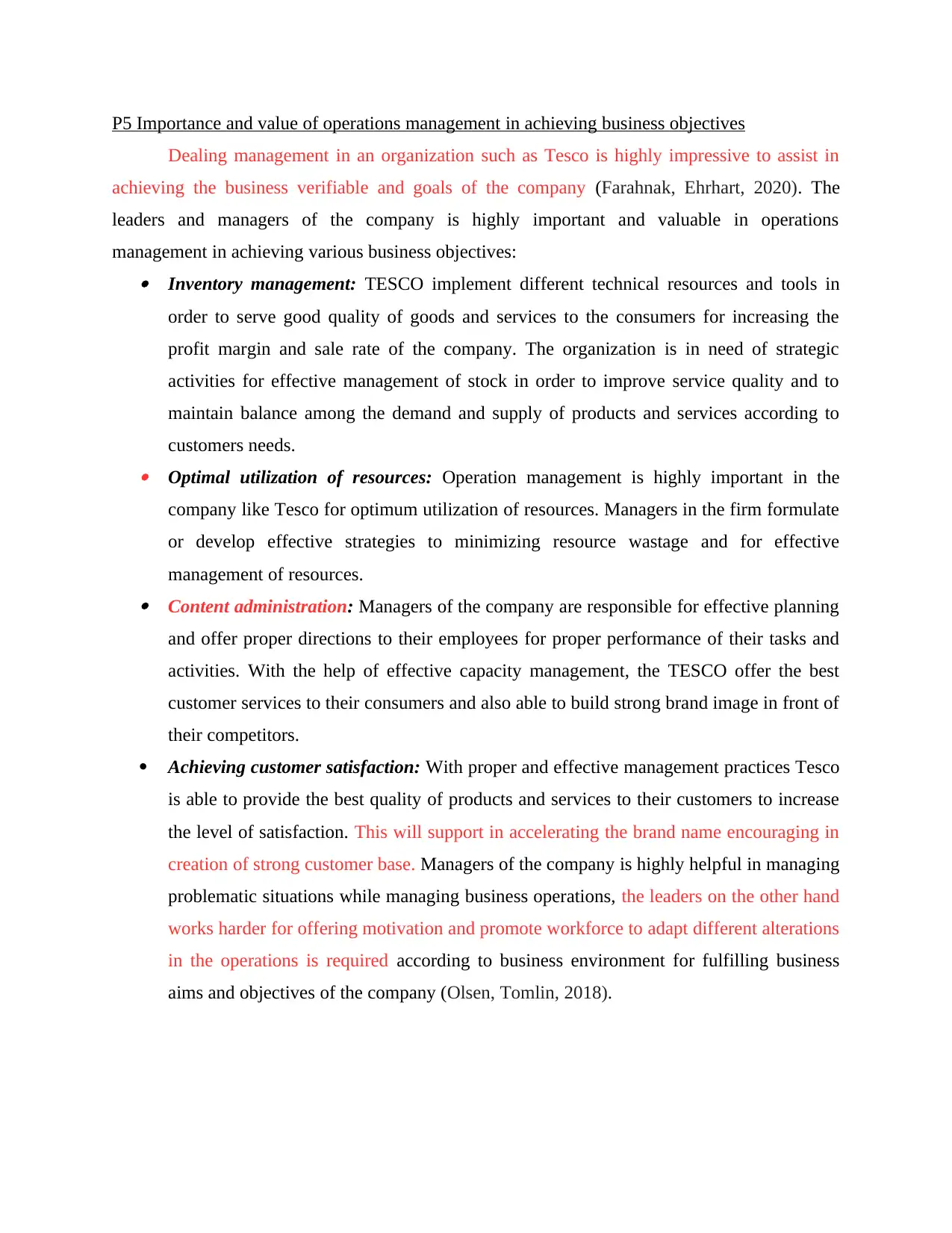
P5 Importance and value of operations management in achieving business objectives
Dealing management in an organization such as Tesco is highly impressive to assist in
achieving the business verifiable and goals of the company (Farahnak, Ehrhart, 2020). The
leaders and managers of the company is highly important and valuable in operations
management in achieving various business objectives: Inventory management: TESCO implement different technical resources and tools in
order to serve good quality of goods and services to the consumers for increasing the
profit margin and sale rate of the company. The organization is in need of strategic
activities for effective management of stock in order to improve service quality and to
maintain balance among the demand and supply of products and services according to
customers needs. Optimal utilization of resources: Operation management is highly important in the
company like Tesco for optimum utilization of resources. Managers in the firm formulate
or develop effective strategies to minimizing resource wastage and for effective
management of resources. Content administration: Managers of the company are responsible for effective planning
and offer proper directions to their employees for proper performance of their tasks and
activities. With the help of effective capacity management, the TESCO offer the best
customer services to their consumers and also able to build strong brand image in front of
their competitors.
Achieving customer satisfaction: With proper and effective management practices Tesco
is able to provide the best quality of products and services to their customers to increase
the level of satisfaction. This will support in accelerating the brand name encouraging in
creation of strong customer base. Managers of the company is highly helpful in managing
problematic situations while managing business operations, the leaders on the other hand
works harder for offering motivation and promote workforce to adapt different alterations
in the operations is required according to business environment for fulfilling business
aims and objectives of the company (Olsen, Tomlin, 2018).
Dealing management in an organization such as Tesco is highly impressive to assist in
achieving the business verifiable and goals of the company (Farahnak, Ehrhart, 2020). The
leaders and managers of the company is highly important and valuable in operations
management in achieving various business objectives: Inventory management: TESCO implement different technical resources and tools in
order to serve good quality of goods and services to the consumers for increasing the
profit margin and sale rate of the company. The organization is in need of strategic
activities for effective management of stock in order to improve service quality and to
maintain balance among the demand and supply of products and services according to
customers needs. Optimal utilization of resources: Operation management is highly important in the
company like Tesco for optimum utilization of resources. Managers in the firm formulate
or develop effective strategies to minimizing resource wastage and for effective
management of resources. Content administration: Managers of the company are responsible for effective planning
and offer proper directions to their employees for proper performance of their tasks and
activities. With the help of effective capacity management, the TESCO offer the best
customer services to their consumers and also able to build strong brand image in front of
their competitors.
Achieving customer satisfaction: With proper and effective management practices Tesco
is able to provide the best quality of products and services to their customers to increase
the level of satisfaction. This will support in accelerating the brand name encouraging in
creation of strong customer base. Managers of the company is highly helpful in managing
problematic situations while managing business operations, the leaders on the other hand
works harder for offering motivation and promote workforce to adapt different alterations
in the operations is required according to business environment for fulfilling business
aims and objectives of the company (Olsen, Tomlin, 2018).
⊘ This is a preview!⊘
Do you want full access?
Subscribe today to unlock all pages.

Trusted by 1+ million students worldwide
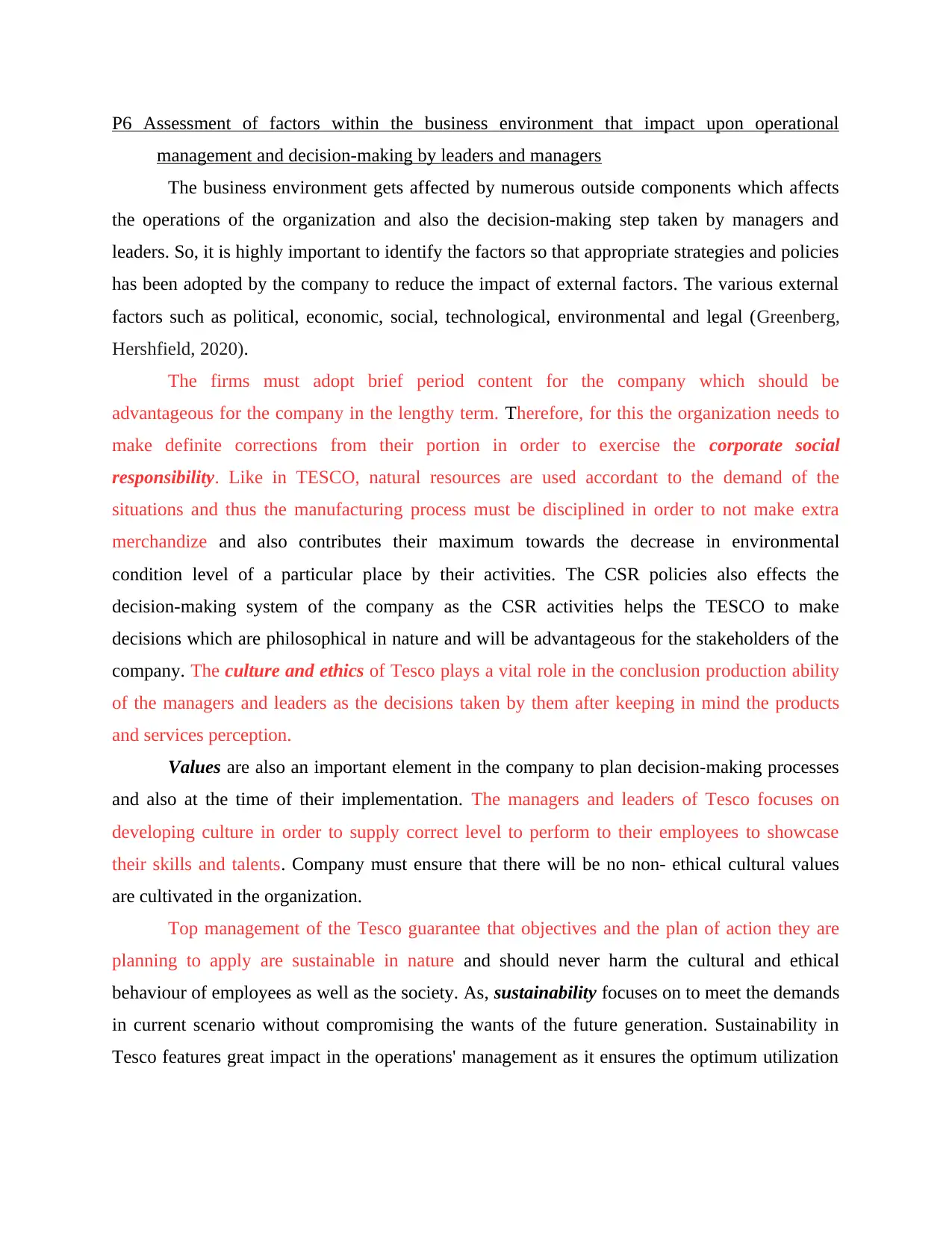
P6 Assessment of factors within the business environment that impact upon operational
management and decision-making by leaders and managers
The business environment gets affected by numerous outside components which affects
the operations of the organization and also the decision-making step taken by managers and
leaders. So, it is highly important to identify the factors so that appropriate strategies and policies
has been adopted by the company to reduce the impact of external factors. The various external
factors such as political, economic, social, technological, environmental and legal (Greenberg,
Hershfield, 2020).
The firms must adopt brief period content for the company which should be
advantageous for the company in the lengthy term. Therefore, for this the organization needs to
make definite corrections from their portion in order to exercise the corporate social
responsibility. Like in TESCO, natural resources are used accordant to the demand of the
situations and thus the manufacturing process must be disciplined in order to not make extra
merchandize and also contributes their maximum towards the decrease in environmental
condition level of a particular place by their activities. The CSR policies also effects the
decision-making system of the company as the CSR activities helps the TESCO to make
decisions which are philosophical in nature and will be advantageous for the stakeholders of the
company. The culture and ethics of Tesco plays a vital role in the conclusion production ability
of the managers and leaders as the decisions taken by them after keeping in mind the products
and services perception.
Values are also an important element in the company to plan decision-making processes
and also at the time of their implementation. The managers and leaders of Tesco focuses on
developing culture in order to supply correct level to perform to their employees to showcase
their skills and talents. Company must ensure that there will be no non- ethical cultural values
are cultivated in the organization.
Top management of the Tesco guarantee that objectives and the plan of action they are
planning to apply are sustainable in nature and should never harm the cultural and ethical
behaviour of employees as well as the society. As, sustainability focuses on to meet the demands
in current scenario without compromising the wants of the future generation. Sustainability in
Tesco features great impact in the operations' management as it ensures the optimum utilization
management and decision-making by leaders and managers
The business environment gets affected by numerous outside components which affects
the operations of the organization and also the decision-making step taken by managers and
leaders. So, it is highly important to identify the factors so that appropriate strategies and policies
has been adopted by the company to reduce the impact of external factors. The various external
factors such as political, economic, social, technological, environmental and legal (Greenberg,
Hershfield, 2020).
The firms must adopt brief period content for the company which should be
advantageous for the company in the lengthy term. Therefore, for this the organization needs to
make definite corrections from their portion in order to exercise the corporate social
responsibility. Like in TESCO, natural resources are used accordant to the demand of the
situations and thus the manufacturing process must be disciplined in order to not make extra
merchandize and also contributes their maximum towards the decrease in environmental
condition level of a particular place by their activities. The CSR policies also effects the
decision-making system of the company as the CSR activities helps the TESCO to make
decisions which are philosophical in nature and will be advantageous for the stakeholders of the
company. The culture and ethics of Tesco plays a vital role in the conclusion production ability
of the managers and leaders as the decisions taken by them after keeping in mind the products
and services perception.
Values are also an important element in the company to plan decision-making processes
and also at the time of their implementation. The managers and leaders of Tesco focuses on
developing culture in order to supply correct level to perform to their employees to showcase
their skills and talents. Company must ensure that there will be no non- ethical cultural values
are cultivated in the organization.
Top management of the Tesco guarantee that objectives and the plan of action they are
planning to apply are sustainable in nature and should never harm the cultural and ethical
behaviour of employees as well as the society. As, sustainability focuses on to meet the demands
in current scenario without compromising the wants of the future generation. Sustainability in
Tesco features great impact in the operations' management as it ensures the optimum utilization
Paraphrase This Document
Need a fresh take? Get an instant paraphrase of this document with our AI Paraphraser
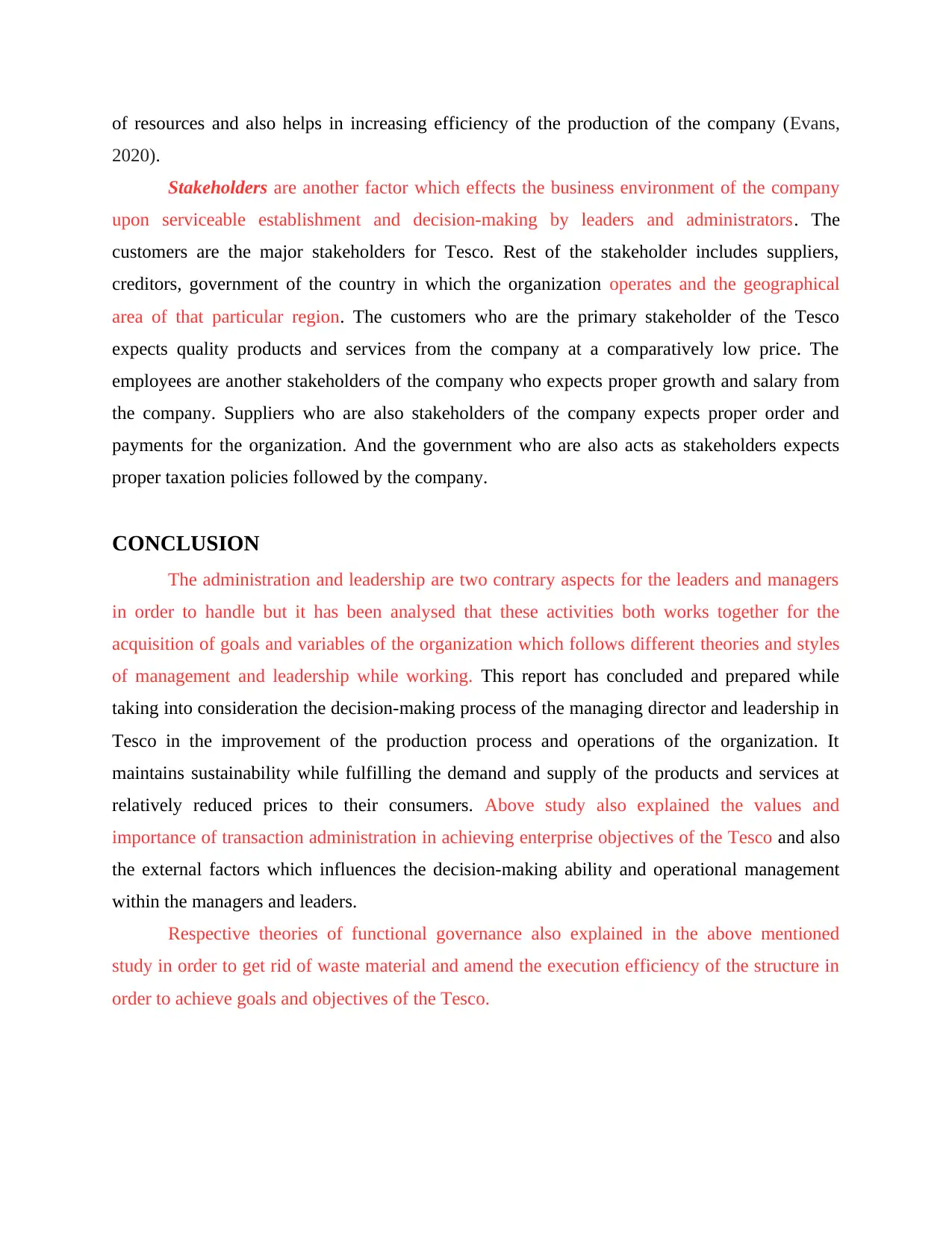
of resources and also helps in increasing efficiency of the production of the company (Evans,
2020).
Stakeholders are another factor which effects the business environment of the company
upon serviceable establishment and decision-making by leaders and administrators. The
customers are the major stakeholders for Tesco. Rest of the stakeholder includes suppliers,
creditors, government of the country in which the organization operates and the geographical
area of that particular region. The customers who are the primary stakeholder of the Tesco
expects quality products and services from the company at a comparatively low price. The
employees are another stakeholders of the company who expects proper growth and salary from
the company. Suppliers who are also stakeholders of the company expects proper order and
payments for the organization. And the government who are also acts as stakeholders expects
proper taxation policies followed by the company.
CONCLUSION
The administration and leadership are two contrary aspects for the leaders and managers
in order to handle but it has been analysed that these activities both works together for the
acquisition of goals and variables of the organization which follows different theories and styles
of management and leadership while working. This report has concluded and prepared while
taking into consideration the decision-making process of the managing director and leadership in
Tesco in the improvement of the production process and operations of the organization. It
maintains sustainability while fulfilling the demand and supply of the products and services at
relatively reduced prices to their consumers. Above study also explained the values and
importance of transaction administration in achieving enterprise objectives of the Tesco and also
the external factors which influences the decision-making ability and operational management
within the managers and leaders.
Respective theories of functional governance also explained in the above mentioned
study in order to get rid of waste material and amend the execution efficiency of the structure in
order to achieve goals and objectives of the Tesco.
2020).
Stakeholders are another factor which effects the business environment of the company
upon serviceable establishment and decision-making by leaders and administrators. The
customers are the major stakeholders for Tesco. Rest of the stakeholder includes suppliers,
creditors, government of the country in which the organization operates and the geographical
area of that particular region. The customers who are the primary stakeholder of the Tesco
expects quality products and services from the company at a comparatively low price. The
employees are another stakeholders of the company who expects proper growth and salary from
the company. Suppliers who are also stakeholders of the company expects proper order and
payments for the organization. And the government who are also acts as stakeholders expects
proper taxation policies followed by the company.
CONCLUSION
The administration and leadership are two contrary aspects for the leaders and managers
in order to handle but it has been analysed that these activities both works together for the
acquisition of goals and variables of the organization which follows different theories and styles
of management and leadership while working. This report has concluded and prepared while
taking into consideration the decision-making process of the managing director and leadership in
Tesco in the improvement of the production process and operations of the organization. It
maintains sustainability while fulfilling the demand and supply of the products and services at
relatively reduced prices to their consumers. Above study also explained the values and
importance of transaction administration in achieving enterprise objectives of the Tesco and also
the external factors which influences the decision-making ability and operational management
within the managers and leaders.
Respective theories of functional governance also explained in the above mentioned
study in order to get rid of waste material and amend the execution efficiency of the structure in
order to achieve goals and objectives of the Tesco.
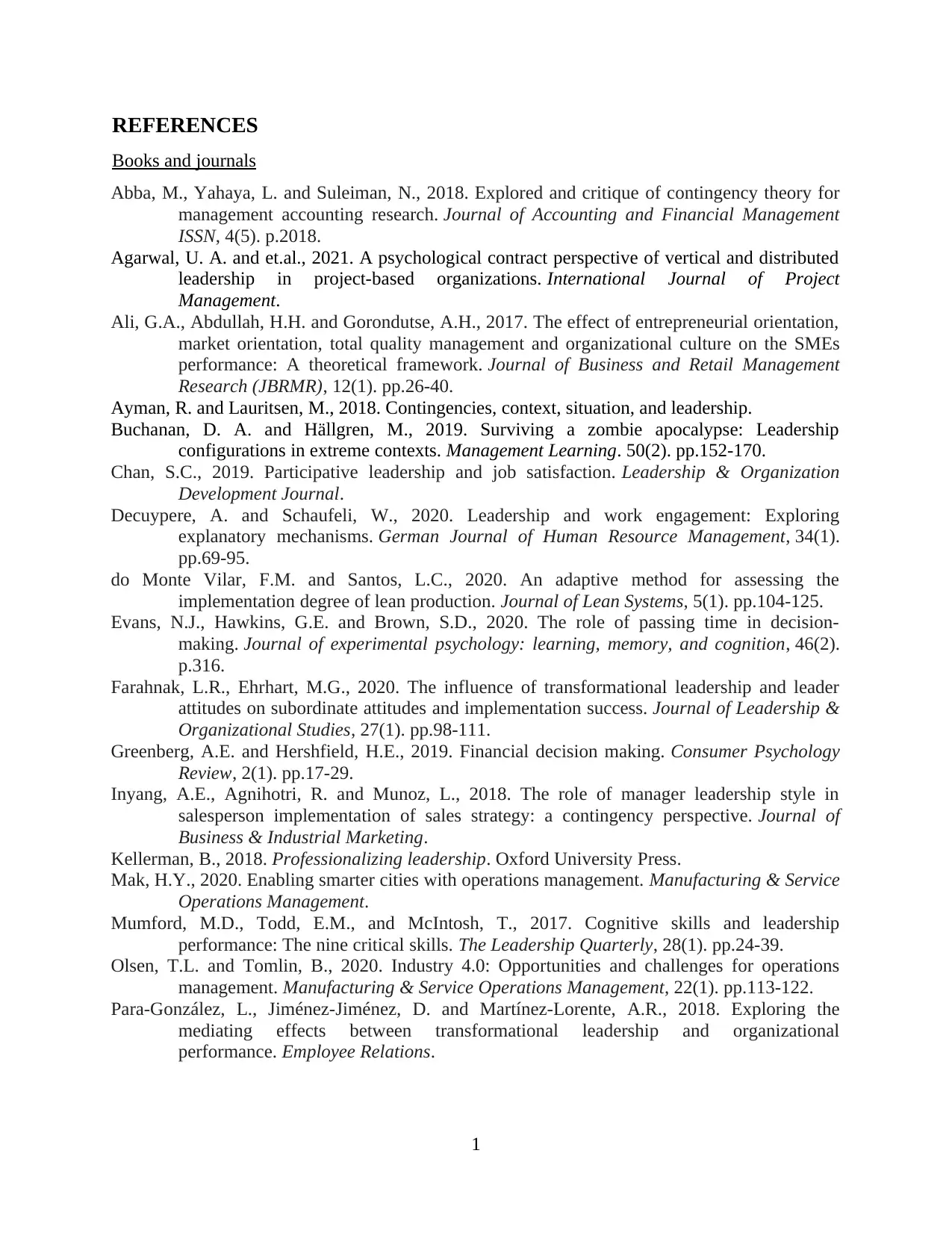
REFERENCES
Books and journals
Abba, M., Yahaya, L. and Suleiman, N., 2018. Explored and critique of contingency theory for
management accounting research. Journal of Accounting and Financial Management
ISSN, 4(5). p.2018.
Agarwal, U. A. and et.al., 2021. A psychological contract perspective of vertical and distributed
leadership in project-based organizations. International Journal of Project
Management.
Ali, G.A., Abdullah, H.H. and Gorondutse, A.H., 2017. The effect of entrepreneurial orientation,
market orientation, total quality management and organizational culture on the SMEs
performance: A theoretical framework. Journal of Business and Retail Management
Research (JBRMR), 12(1). pp.26-40.
Ayman, R. and Lauritsen, M., 2018. Contingencies, context, situation, and leadership.
Buchanan, D. A. and Hällgren, M., 2019. Surviving a zombie apocalypse: Leadership
configurations in extreme contexts. Management Learning. 50(2). pp.152-170.
Chan, S.C., 2019. Participative leadership and job satisfaction. Leadership & Organization
Development Journal.
Decuypere, A. and Schaufeli, W., 2020. Leadership and work engagement: Exploring
explanatory mechanisms. German Journal of Human Resource Management, 34(1).
pp.69-95.
do Monte Vilar, F.M. and Santos, L.C., 2020. An adaptive method for assessing the
implementation degree of lean production. Journal of Lean Systems, 5(1). pp.104-125.
Evans, N.J., Hawkins, G.E. and Brown, S.D., 2020. The role of passing time in decision-
making. Journal of experimental psychology: learning, memory, and cognition, 46(2).
p.316.
Farahnak, L.R., Ehrhart, M.G., 2020. The influence of transformational leadership and leader
attitudes on subordinate attitudes and implementation success. Journal of Leadership &
Organizational Studies, 27(1). pp.98-111.
Greenberg, A.E. and Hershfield, H.E., 2019. Financial decision making. Consumer Psychology
Review, 2(1). pp.17-29.
Inyang, A.E., Agnihotri, R. and Munoz, L., 2018. The role of manager leadership style in
salesperson implementation of sales strategy: a contingency perspective. Journal of
Business & Industrial Marketing.
Kellerman, B., 2018. Professionalizing leadership. Oxford University Press.
Mak, H.Y., 2020. Enabling smarter cities with operations management. Manufacturing & Service
Operations Management.
Mumford, M.D., Todd, E.M., and McIntosh, T., 2017. Cognitive skills and leadership
performance: The nine critical skills. The Leadership Quarterly, 28(1). pp.24-39.
Olsen, T.L. and Tomlin, B., 2020. Industry 4.0: Opportunities and challenges for operations
management. Manufacturing & Service Operations Management, 22(1). pp.113-122.
Para-González, L., Jiménez-Jiménez, D. and Martínez-Lorente, A.R., 2018. Exploring the
mediating effects between transformational leadership and organizational
performance. Employee Relations.
1
Books and journals
Abba, M., Yahaya, L. and Suleiman, N., 2018. Explored and critique of contingency theory for
management accounting research. Journal of Accounting and Financial Management
ISSN, 4(5). p.2018.
Agarwal, U. A. and et.al., 2021. A psychological contract perspective of vertical and distributed
leadership in project-based organizations. International Journal of Project
Management.
Ali, G.A., Abdullah, H.H. and Gorondutse, A.H., 2017. The effect of entrepreneurial orientation,
market orientation, total quality management and organizational culture on the SMEs
performance: A theoretical framework. Journal of Business and Retail Management
Research (JBRMR), 12(1). pp.26-40.
Ayman, R. and Lauritsen, M., 2018. Contingencies, context, situation, and leadership.
Buchanan, D. A. and Hällgren, M., 2019. Surviving a zombie apocalypse: Leadership
configurations in extreme contexts. Management Learning. 50(2). pp.152-170.
Chan, S.C., 2019. Participative leadership and job satisfaction. Leadership & Organization
Development Journal.
Decuypere, A. and Schaufeli, W., 2020. Leadership and work engagement: Exploring
explanatory mechanisms. German Journal of Human Resource Management, 34(1).
pp.69-95.
do Monte Vilar, F.M. and Santos, L.C., 2020. An adaptive method for assessing the
implementation degree of lean production. Journal of Lean Systems, 5(1). pp.104-125.
Evans, N.J., Hawkins, G.E. and Brown, S.D., 2020. The role of passing time in decision-
making. Journal of experimental psychology: learning, memory, and cognition, 46(2).
p.316.
Farahnak, L.R., Ehrhart, M.G., 2020. The influence of transformational leadership and leader
attitudes on subordinate attitudes and implementation success. Journal of Leadership &
Organizational Studies, 27(1). pp.98-111.
Greenberg, A.E. and Hershfield, H.E., 2019. Financial decision making. Consumer Psychology
Review, 2(1). pp.17-29.
Inyang, A.E., Agnihotri, R. and Munoz, L., 2018. The role of manager leadership style in
salesperson implementation of sales strategy: a contingency perspective. Journal of
Business & Industrial Marketing.
Kellerman, B., 2018. Professionalizing leadership. Oxford University Press.
Mak, H.Y., 2020. Enabling smarter cities with operations management. Manufacturing & Service
Operations Management.
Mumford, M.D., Todd, E.M., and McIntosh, T., 2017. Cognitive skills and leadership
performance: The nine critical skills. The Leadership Quarterly, 28(1). pp.24-39.
Olsen, T.L. and Tomlin, B., 2020. Industry 4.0: Opportunities and challenges for operations
management. Manufacturing & Service Operations Management, 22(1). pp.113-122.
Para-González, L., Jiménez-Jiménez, D. and Martínez-Lorente, A.R., 2018. Exploring the
mediating effects between transformational leadership and organizational
performance. Employee Relations.
1
⊘ This is a preview!⊘
Do you want full access?
Subscribe today to unlock all pages.

Trusted by 1+ million students worldwide
1 out of 13
Related Documents
Your All-in-One AI-Powered Toolkit for Academic Success.
+13062052269
info@desklib.com
Available 24*7 on WhatsApp / Email
![[object Object]](/_next/static/media/star-bottom.7253800d.svg)
Unlock your academic potential
Copyright © 2020–2025 A2Z Services. All Rights Reserved. Developed and managed by ZUCOL.





